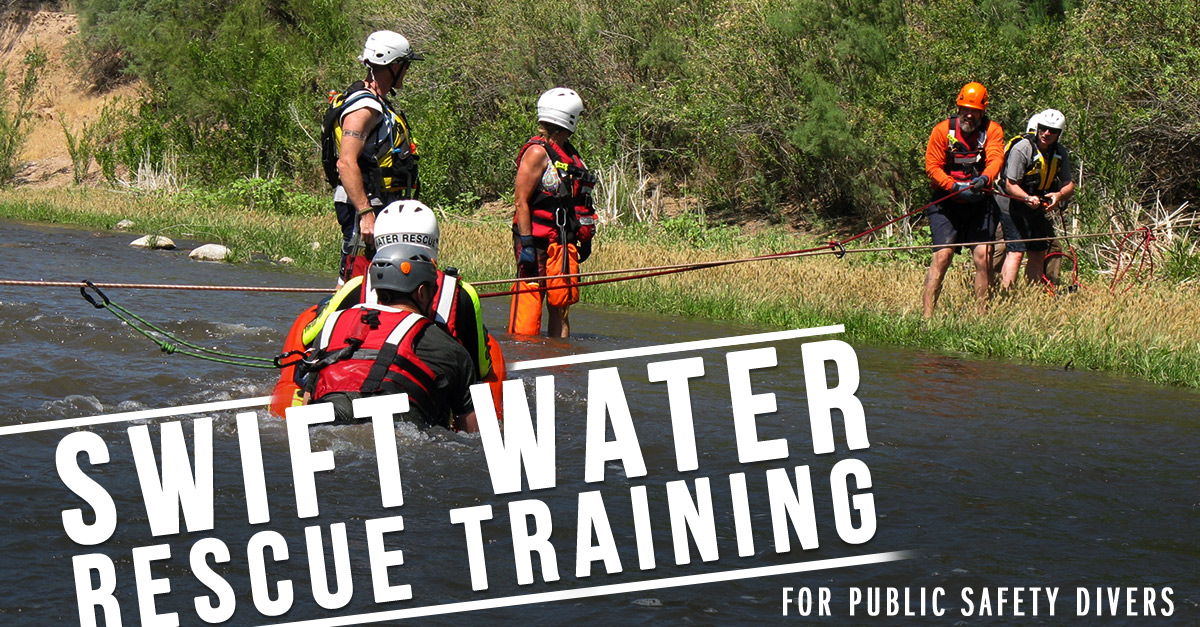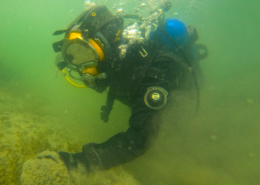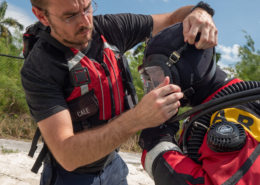Swift Water Rescue Training for Public Safety Divers
By: Eric Brooks
It is important for swift water rescue teams to practice scenarios that they will likely encounter when responding to a mission. It is equally important that swift water rescue teams pay attention to the actions of the public when they are conducting training; rescue situations may arise while training scenarios are being completed.
As part of our regular training regimen, the Cochise County Sheriff’s Office Search and Rescue Swift Water team heads 250 miles north to the Salt River for its annual pre-monsoon, pre-Swift Water Rodeo training. The schedule typically consists of swift water skills training for new members of the team and refresher skills, such as throw bag practice and paddling skills, for seasoned members of the team. Additionally, current members of the team act as victims for the new “students.” The day starts early and ends with a late drive back to Sierra Vista, but all involved will agree that the training is very beneficial and very important for honing skills prior to what could turn out to be a busy swift water season.
This year’s training started out no differently than any other year’s training.
We arrived at the Phon D. Sutton Recreational area bright and early Saturday morning and began setting up for the day’s training. After unloading all of our gear and completing a safety briefing, we hit the water for self-rescue skills for new team members, and throw bag practice for current team members. The morning was spent floating down the rapid section (and swimming bank to bank) at the confluence of the Verde and Salt Rivers. This year, and unlike any of the years past, the Salt River was flowing lower than normal and the Verde River was flowing much faster than usual. What this meant for our rapid section is that the upper portion of the rapids was fairly mild, but the lower section of the rapids, below the Verde, was much more aggressive than it had been in the past. This was good for us, and we took advantage of the environmental change, using it as a way to switch up training from previous years.
After lunch, the training was to be moved to take advantage of the faster-moving water coming down the Verde River and to give the new team members a chance to work through scenarios using ropes and a rather large inflatable rescue board. The first evolution for the afternoon was to put three victims on the opposite shore and have the four new members bring them back to our bank using any rope system they could muster. Their only limitation was the equipment that we had carried with us across the Salt River.
Prior to completing the scenario described above, the new team members needed to negotiate a strainer as the last part of their self-rescue training. After considering all of the possible paces to set up the strainer and the hazards that were involved, a small section of rapids just above the confluence was chosen as the best place to complete the training. It was not necessarily an ideal place to complete this portion of the training, but it was sufficient and posed the least amount of problems for the dozens of people who were now at the river enjoying a day in the sun.
A young boy and what appeared to be his even younger sister approached the top of the rapid section
As the students and I began heading back across the Salt to set up the strainer and begin this evolution, a young boy and what appeared to be his even younger sister approached the top of the rapid section that we had chosen for our strainer practice (of course they were not wearing PFDs and no adult supervision was apparent). The senior members of the team had remained on the far side of the rapids in order to set up the far side anchor for the strainer and keep an eye out for any kayakers that may have been floating down the river. As I began climbing onto a rather large rock on my side of the rapids, ERDI Swift Water Instructor William Jordan (#13050) and CCSO Sergeant and SAR coordinator David Noland began communicating with me that the girl was having some difficulties with these mild rapids; she was attempting to grab the rock and climb out, but was unsuccessful. I quickly moved to a lower section of the rapids, below the rock I was traversing and found the girl attempting to climb out of the water. There was a small Eddy and low spot in the rocks right at the very top of the confluence. As the girl tried to climb to safety, just before I could reach her, she was sucked backed into the water and into the much faster flowing, longer rapid section of the Verde. Having no one downstream of this point to catch her, I leaped into the water and swam as aggressively as possible to her. I was able to make contact with the girl just as her head went under in the most dangerous part of the rapids. We quickly grabbed the nearest Eddy and as I exited the water with her. A quick glanced down stream confirmed that her brother had climbed out of the rapids and onto the rocks.
The lessons here…
The lessons here for parents and the reoccurring themes that we constantly hear on the news every summer are: “Don’t let your kids near the water unattended” and “children should wear life jackets around water.” The lesson here for rescue teams is to be prepared and keep your eyes and ears open during training sessions. You never know when a training session will turn into an actual rescue. It is likely that had it not been for the keen observations of two senior members of our swift water team, I would not have been in a position to get to the girl and this could have quickly turned into a possible drowning, or worst yet a body recovery.
About the Author:
Eric Brooks, MEd, PhD, TDI/SDI/ERDI Instructor Trainer #8699, and owner of ProTech Scuba LLC, has been with the Cochise County Sheriff’s Office Search and Rescue unit as a volunteer since 1999. He is the senior swift water and dive team instructor and also teaches low angle rope rescue and land navigation.
Contact SDI TDI and ERDI
If you would like more information, please contact our World Headquarters or your Regional Office.
Tel: 888.778.9073 | 207.729.4201
Email: Worldhq@tdisdi.com
Web: https://www.tdisdi.com
Facebook: www.facebook.com/PublicSafetyDiving




 Y. ZIN
Y. ZIN




Zanechajte komentár
Chcete sa pripojiť k diskusii?Neváhajte prispieť!